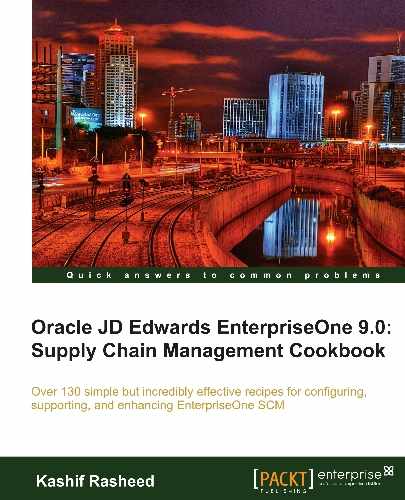Issuing inventory typically involves removing items from a branch/plant or location, adjusting the inventory balance, and recording the transaction in the GL. Setup for inventory issues is done through the Inventory Issue Application (P4112) processing option.
Before you complete the tasks in this recipe, you must:
- Verify the Item and branch/plant information in the item branch file (F4102) and the item location file F41021 tables
- Set up general ledger accounts in the account master F0901 table
- Set up processing options for Inventory Issues (P4112)
- You can access the processing option of P4112 by accessing the EnterpriseOne Menus | Logistics Management | Inventory Management | Inventory Management | Daily Processing | Inventory Master/Transaction and click on the arrow on Issues and then click on Values.
- Enter a code from UDC 00/DT that specifies the document type. The default document type is typically II (Inventory Issues). You can enter the document type or select it from the Select User Defined Code form. The system does not provide any default value.
- Specify whether the system supplies default values for the Location and Lot serial fields.
- Specify the version of the journal entries program to use when you access the program from the row menu of the Work With Inventory Issues form.
- Specify the version of the item ledger inquiry program to use when you access the program from the row menu of the Work With Inventory Issues form.
- Specify the version of the manual replenishments program to use when you access the program from the form menu of the Work With Inventory Issues form.
- Specify whether equipment and subledger information appears in the detail area of the Work With Inventory Issues form.
- Issue Quantity specifies whether to allow an issue quantity that is greater than the available quantity, which could result in a negative on-hand quantity. Leave this processing option blank in order to avoid the Available and On-hand Quantity becoming negative.
- Lots on Hold specifies whether the system allows the issue of lots that are on hold. If the lot status code field on the item/branch plant information form is blank, then the lot is not on hold. Leave this processing option blank in order to avoid issuing lots that are on hold.
- Use the Item Sales History Processing option to update the Item History Table (F4115) if you use the Inventory Management system, and do not use the Sales Order Management system.
- The Secondary Quantity Unit of Measure option in the Inventory Constants field appears on data entry screens. For the secondary UOM (Unit of Measure), enter a code from UDC 00/UM that indicates an alternate unit of measure for the item.

The system processes the transaction and displays the document number, document type, and batch number for the transaction. For zero unit cost, the system changes the Unit Cost field to zero and the Extended Amount field to blank. The fields are not available for entry. When you move the cursor to the next row, the program uses the default values in the Item Cost File (F4105) to complete the unit cost and extended amount fields. To issue inventory, you must enter transaction, item, and accounting information. You can also enter issue-related information for each branch/plant in which an item is stored.
When you enter a transaction, the system displays a document type, batch number, and document number.
Depending on how you set the processing options, you may be able to issue a quantity that is greater than the on-hand quantity for the parent item in a kit. The system displays the parent quantity as a negative number. You can correct an issue that was made in error by creating a reversing entry. Because records of each inventory transaction are kept for accounting purposes, you cannot delete the record. A reversing entry enters a positive quantity and cost amount back into the item information.
When you select subledger information from the form menu, the account information form displays the fields for account number and subledger information, but does not display the equipment field.
The account number specifies whether the system requires the entry of account numbers (for example, Business Unit.Object.Subsidiary) in the detail area of the inventory issues form.
Journal entries specify whether detailed or summarized journal entries should be created from the Inventory Issues (P4112) program in the general ledger. If detailed journal entries are created, the system creates one journal entry (debit or credit) for each detail line in an issue, using a batch type of N. This processing option affects journal entries in the F0911 table only. The AAIs that are most commonly used are 4122 (Inventory) and 4124 (Expense or COGS). If you use standard costs, the system might create journal entries for the variance based on AAI item 4141 (Inventory or Expense COGS). The F4111 table contains information for each detail line in each issue regardless of the value of this processing option. If summarized journal entries by account number are created, the system creates a summarized debit total and a summarized credit total per account nu mber for all lines in an issue.
For example, a company that operates a consignment warehouse might use the P4112 program only to reduce inventory. However, the company might want to review historical information about issues by reviewing buyer information, which you can access from the Inventory Inquiries Menu (G41112). If you are using the sales order management system, the system can update the Item History (F4115) table as a result of sales transactions that are part of the sales updating process.
- Setting up inventory transactions in Chapter 1,Inventory Management
